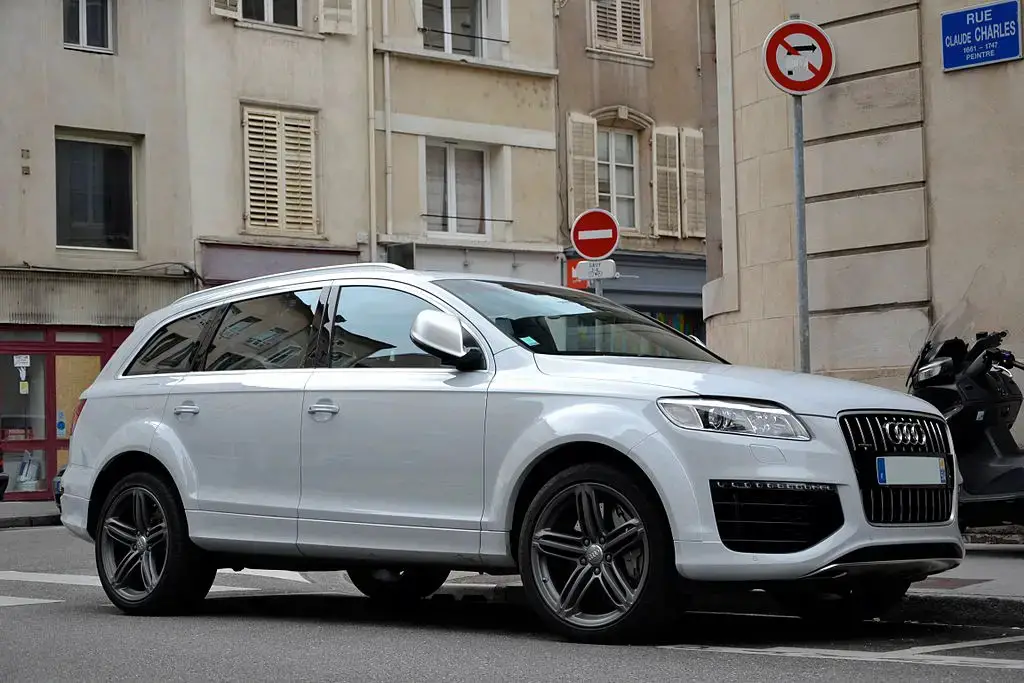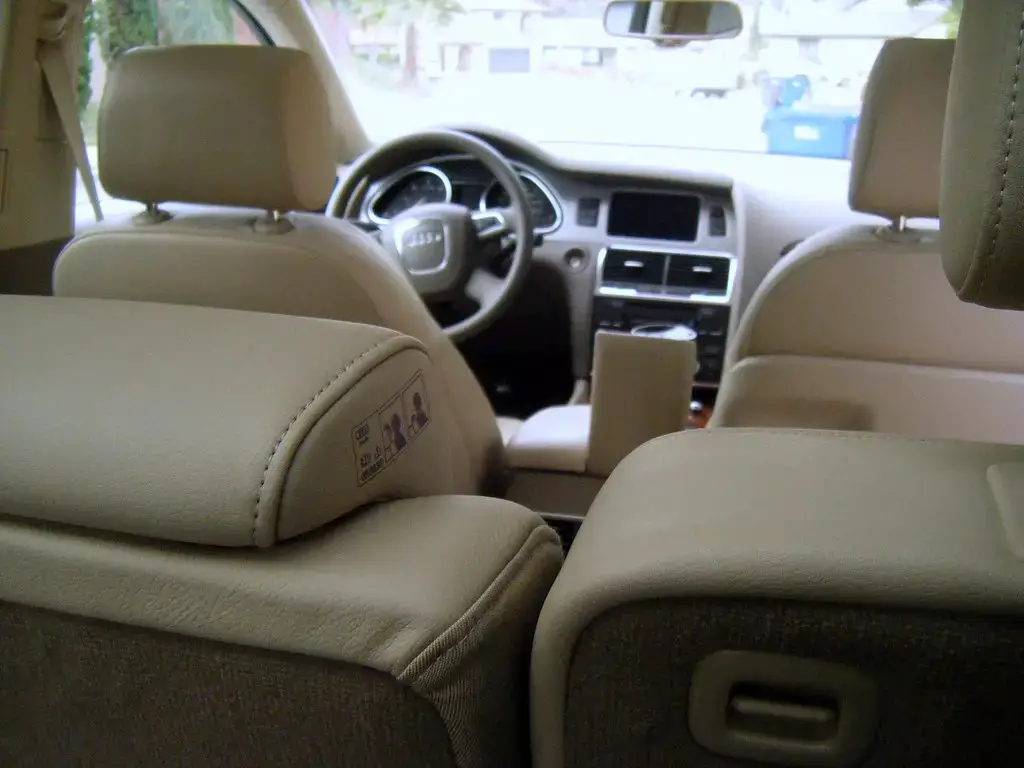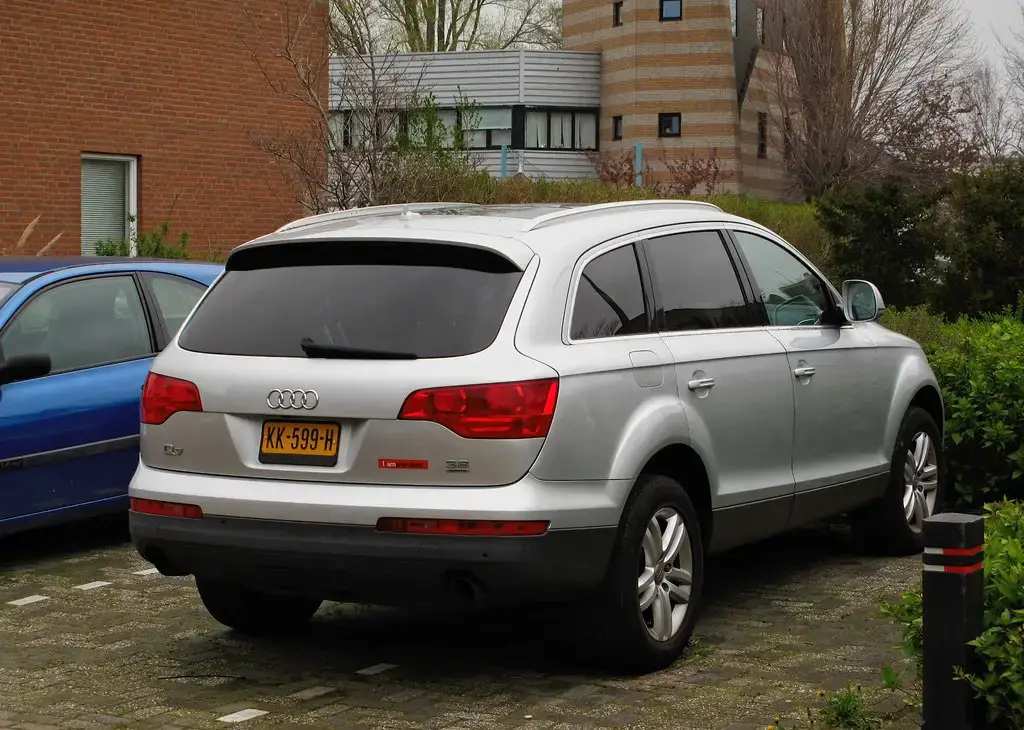Review : Audi Q7 I ( 2006 – 2015 )

Audi Q7 I, the official car mobster car of 2008. Audi Q7, the official car of throwing money out of the window. In 2008. Audi Q7 I, I guess I’ll have fun with this article.
The Audi Q7 I was first launched in 2002 at an American car show as an image exercise. Kind of like what would 50 Cent drive if he were allergic to burgers and Coke Zero. Only that the concept was so successful that Audi decided to put the Audi Q7 I mastodon into production, and in 2005 it was ready to go and in 2006 it was already at dealerships, put up for sale for prices of 6 digits in $. And because they wanted to launch it as soon as possible, they based the Q7 on the Touareg and Cayenne platform, after which they pulled it by the legs and stretched it to an absolutely decent and sensible 5,085 meters, that is 5.1 -meters-does-it-even-matter in length. Because when you have a Q7, size doesn’t matter anymore. The interior space is measured in acres, the engine capacity is measured in barrels and the value is measured in Macklemore’s bling.
In Europe however, we don’t have 50 Cent. We have instead an army of refined gentlemen. People who usually wear satin shirts 2 sizes smaller, to highlight their bare chest and lower abdomen. People who made a lot of money in 2007 from various sources. And speaking of 2007, the Audi Q7 I was one of the leading cars before the crisis and one of it’s first victims. Who you see today driving around in an Q7 of the first generation are either bands who need those 7 seats for the whole band + clarinet, or people who have chosen other paths in life. People who can afford to buy them but not necessarily maintain them. Because the Audi Q7 was a car built for the American public, right before the crisis, when people were throwing money out the window. And a lot of money was thrown out of the window of the Audi Q7 I.

Audi Q7 I Engines
Petrol
- 3.0 Turbo V6 of 272 and 333 horsepower – Launched in 2010 on the facelift version, the smallest engine on the Audi Q7 I offers adequate performance for this mastodon. Not great, adequate. Yes, there are occasional issues with the oil consumption, but believe me this is your last problem when talking about Audi Q7 maintainance.
- 3.6 V6 FSI BLW and BWS of 276 horsepower – Probably the most reliable engine on the first Q7, but unfortunately it doesn’t go well with the LPG system. But at least it’s the kind of engine where you put gas and change the oil and filters on time and that’s about it.
- 4.2 V8 FSI AXQ and BAR of 345 horsepower – We are already in the car stratosphere, where a scratch turns into a deep cut. FSI and TFSI engines have issues with carbon deposits on the valves, but in a small engine it’s usually a negligible amount. For a refrigerator-sized engine, on the other hand, these deposits can cut up to 50 horsepower if you don’t clean them up. Basically, a 1.0 Lupo engine comes out of your engine and leaves. There is no point in talking about the rest of the maintenance.
Diesel
- 3.0 TDI V6 CRC of 230 and 240 horsepower – The most popular engine on the Audi Q7 I by far, this luxury village bicycle has been mounted on everything from VW Fox to Audi Q7. Wait, we’re already in Q7. Up to the Audi A8. There are no particular issues, only the timing chain costs so much to replace that many prefer to sell the car rather than to take the plunge and do it.
- 4.2 TDI V8 BTR of 335 horsepower – Elastic, fantastic, bombastic. That’s how I should describe the engine, but unfortunately it’s not the final step towards the diesel throne on the Audi Q7 I. Basically, if you have a heart attack you die standing up. Same goes for this engine, as working on it means that the engine must be taken out most of the time and your ass will hurt so bad that you will think you had a private session with Lunk.
- 6.0 TDI V12 CCGA of 500 horsepower and 1000 Nm of torque – I don’t normally mention torque because no one cares about it, but at 1000 Nm of torque, this engine was the pinnacle of car madness and something we’ll never see again. If a Terracan can tow the Lenin Palace while climbing the Ural Mountains, the Audi Q7 6.0 TDI V12 tows the Ural Mountain range directly. Does it still make sense to talk about this engine and the fact that you have to be at least dedicated in order to own and maintain something like this?

Audi Q7 I General Issues
- I’ll start with the big one, literally. Audi Q7 I occupies 8 acres and weighs 4000 tons. That translates into huge stress on the brakes, tires, suspension and just about everything that holds the car. Legend has it that 21″ rim tires do not reach the 10,000 kms / 6000 miles milestone.
- The automatic transmission is decent most of the time, but if you go in the 4.2 TDI area and beyond, it can’t handle the torque anymore. And when it dies off, you’ll have to change the car because it’s not worth it.
- The MMI navigation system is the same “quality” that Audi got us used to in the 2005s, so either you get used to it being broken all the time, or you replace it again and again until you book yourself at the Broadmoor psychiatric hospital.
- The air suspension also collapses under the weight of this 10-store mall-on-wheels called the Audi Q7, so put the money aside because you will constantly replace the airbags and compressors.

Audi Q7 I Verdict
One of the official cars of the 2008 crisis, the Audi Q7 I today is a rarer presence than my lucidity moments. A car made in excess, in a period of excess, for people who love excess. God, I love this car. Represents everything that is wrong with the SUV: Big, expensive, thirsty and not necessarily beautiful. It’s such a bad car that it’s great. Does anyone have 5,000 euros to lend until tomorrow so that I can buy one too?
Which engines do I recommend? As far as petrol is concerned, the fight is between 3.0 TFSI and 3.6 FSI, although strictly in terms of reliability 3.6 FSI beats the meat. As for diesel, everyone will be crowding for the 3.0 TDI anyway.
Similar Articles

Review : Skoda CitiGO ( 2011 - 2020 )

Review : Seat Mii ( 2011 - 2020 )

Review : VW Up! ( 2011 - 2023 )
Write an answer
- Review : Skoda CitiGO ( 2011 - 2020 ) 02 August 2025
- Review : Seat Mii ( 2011 - 2020 ) 02 August 2025
- Review : VW Up! ( 2011 - 2023 ) 16 July 2025
- November 2025
- October 2025
- August 2025
- July 2025
- April 2025
- March 2025
- February 2025
- January 2025
- December 2024
- November 2024
- October 2024
- August 2024
- July 2024
- June 2024
- May 2024
- April 2024
- March 2024
- February 2024
- January 2024
- December 2023
- November 2023
- October 2023
- September 2023
- August 2023
- July 2023
- June 2023
- May 2023
- April 2023
- March 2023
- February 2023
- January 2023
- December 2022
- November 2022
- October 2022
- September 2022
- August 2022
- July 2022
- June 2022
- May 2022
- March 2022
- April 2021
- January 2021
- December 2020
- November 2020
- October 2020
- September 2020
- August 2020
- July 2020
- March 2020